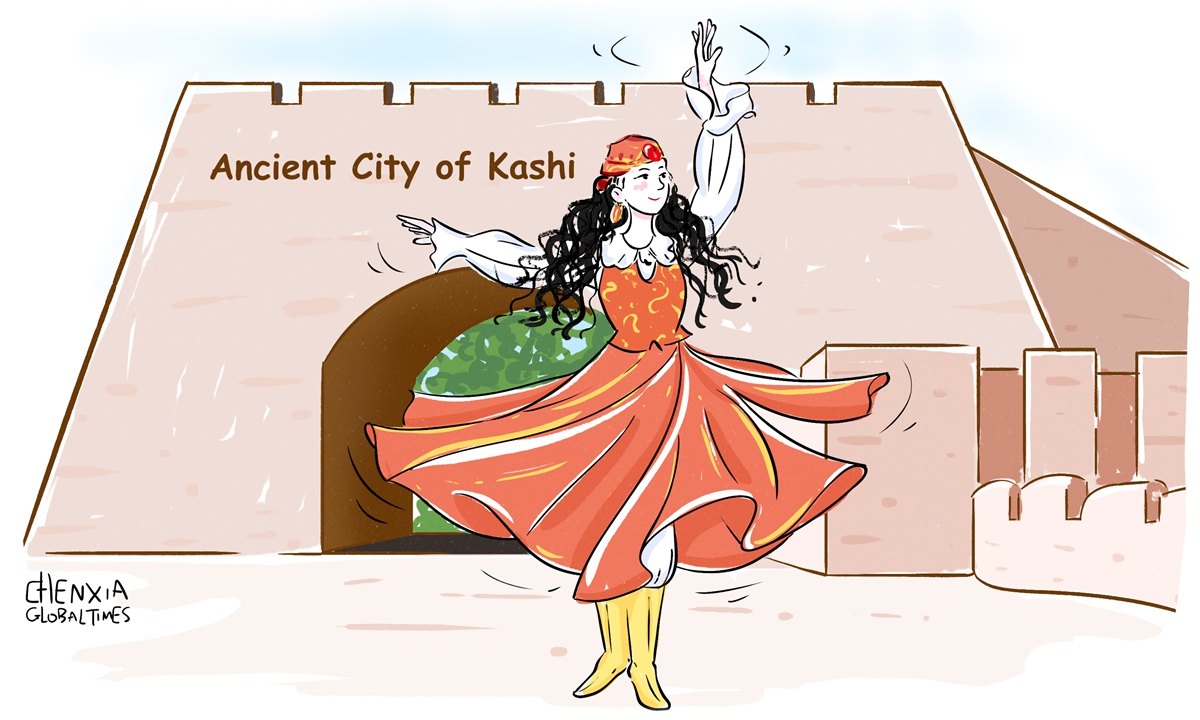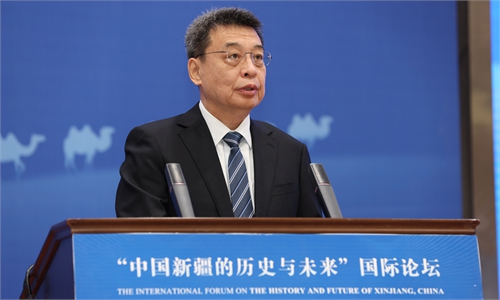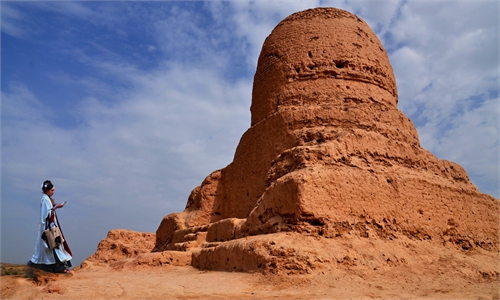ARTS / CULTURE & LEISURE
Xinjiang’s rich culture thrives in Kashi

Illustration: Chen Xia/GT
Qi Liu is a graduate student of archaeology at Minzu University of China in Beijing. She has been doing excavation work and research with her advisor's team at the Mo'er Temple ruins in Kashi, Northwest China's Xinjiang Uygur Autonomous Region.
"This is the head of the Buddha. It was originally painted with very beautiful colors, which faded after being unearthed. Here are some more remnants of Budda statues that showcase various artistic styles," Qi introduced to international experts who were visiting the Kashi Museum.
Last week, global experts gathered in Kashi to exchange views about the archaeological discoveries at the excavated Mo'er Temple at the international forum "The History and Future of Xinjiang, China."
Dating back to the 3rd century AD and gradually abandoned after the 10th century, the Mo'er Temple ruins are among the earliest Buddhist sites discovered in the region. The best-preserved earthen Buddhist stupa in the westernmost part of China, the temple is evidence that Buddhism once spread and flourished in ancient times in Xinjiang.
While the Buddhist art remnants found here indicate that Xinjiang's history is one of coexistence of multiple religions, they also reflect the overall characteristics of Chinese civilization: diversity, inclusiveness, and continuity.
In analyzing the Buddha statues, researchers discovered they possessed richly varied craftsmanship and elements from Buddhist iconography, incorporating both the Gandhara style and characteristics from China's Central Plains. This indicates that Buddhism underwent several transformations influenced by various cultures.
In addition to visiting the Kashi Museum and the Mo'er Temple ruins, the international experts also explored the rich cultural heritage of Xinjiang through visits to cultural sites such as the Id Kah Mosque and the Ancient City of Kashi.
Near the Ancient City of Kashi stands the Gaotai ancient residences. International experts were amazed by the traditional Uygur architecture. Constructed of soil and poplar wood, the houses are multi-story adobe houses constructed closely together on a cliff side. These homes are not only a tourist attraction but also an important part of the living history of the Uygur people, reflecting their adaptation to the natural environment and their architectural ingenuity.
Walking through the Ancient City of Kashi, visitors can see a variety of shops and stalls everywhere, including various traditional Uygur pottery, food, handicrafts and even musical instruments, some of which have been enlisted as intangible cultural heritage at various levels.
This is the only 5A-level historical and cultural scenic area in Xinjiang, which is why it is known for the saying, "You haven't truly been to Xinjiang if you haven't visited Kashi, and you haven't truly been to Kashi if you haven't seen the ancient city."
Divided into eastern and western sections, the ancient city is located in the heart of Kashi. With a history spanning over 1,000 years, it is one of the largest extant earthen complexes in the world.
Every day at 10:30 am and 6:00 pm, the city hosts an opening ceremony. Despite not being a holiday, half an hour before the performance on Friday, the main gate of the ancient city was already surrounded by crowds.
Tourists from across the country eagerly awaited the performance so they could enter the city for a tour. An employee responsible for maintaining order told the Global Times that the crowds are even larger during holidays.
The current prosperity of the ancient city is the result of a major renovation a decade ago. The ancient city was once the largest shantytown in Kashi, filled with dilapidated, makeshift buildings that posed significant safety hazards and inconvenience to daily life. Rainfall would also further obstruct the alleys.
In 2010, a comprehensive project, with a budget of 7.049 billion yuan ($971 million) and involving about 220,000 residents, to renovate the Ancient City of Kashi was launched. Following the principle of "restoring the old to its original appearance," 49,083 traditional residences of historical and cultural value were renovated and reinforced while preserving their original layout.
Numerous ancient alleys were reconstructed, and unique street blocks were progressively planned and completed. Various historical sites, pavilions, and towers throughout the ancient city were either newly built, renovated, or decorated, presenting a new look for the ancient city.
The renovation project not only improved the dilapidated old houses but also enhanced internal infrastructure, preserving and showcasing the historical and cultural heritage of Kashi.
A staff member at the Ancient City Renovation and Comprehensive Management Memorial Hall told the Global Times that the renovation transformed the ancient city and also significantly improved the living conditions of local residents.
Besides this, the reputation of the ancient city has soared, and tourism has rapidly improved, leading to a thriving community with residents living in peace and contentment.
The authors are reporters with the Global Times. life@globaltimes.com.cn


